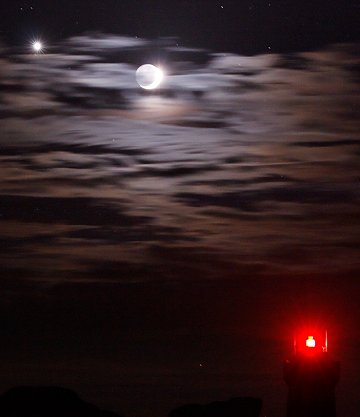 He already has a neck tie. This year give Dad something truly heavenly for Father's Day: SpaceWeather PHONE. He already has a neck tie. This year give Dad something truly heavenly for Father's Day: SpaceWeather PHONE. LUNAR ECLIPSE OF SATURN: If you live in Europe or North Africa, you may be able to see a lunar eclipse of Saturn tonight. The event begins around 1930 UT on May 22 when the dark edge of the Moon covers Saturn's rings. Saturn emerges from eclipse about an hour later. Click here for a detailed time table, and ready your telescopes! A WEEK OF MAGNETISM: One week ago, sunspot 956 was crackling with solar flares and emitting radio bursts so strong, they startled ham radio operators on Earth. Now the sunspot is quiet and fading fast. What happened? This movie provides the answer: 
This is a solar magnetogram, or magnetic map of the sun, obtained by the SOHO spacecraft and animated to show the development of sunspot 956 between May 15th and May 22nd. At the beginning of the movie, we see a dense knot of magnetism (sunspot 956) where opposite polarities are gathered in close proximity. Active sunspots rely on such gatherings: Opposite polarities pressed tightly together explode via a process called reconnection, leading to flares and radio bursts. At the end of the movie we see the magnetic fields dispersing. This is the situation today, and explains why sunspot 956 is quieting. BONUS: Even as it fades, sunspot 956 is still a beautiful sunspot, as shown in this picture taken a few hours ago by Jean-Marc Lecleire of Torcy, France. WATER WORLDS: There's a lot of water in this photo. Can you find it? 
Photo details: Canon 30D, 70 mm lens, 10 seconds exposure.
Answer: It's in the clouds. The glowing blue and straw-colored "aureoles" around the Moon are caused by water droplets scattering moonlight in the clouds. Photographer Laurent Laveder took the picture on May 19th from Trégastel beach in France. "The clouds added a nice 'atmosphere' to the scene," he says. Incidentally, the two worlds behind the clouds--the Moon and Venus--are among the driest places in the solar system. The Moon is dry because its surface temperature soars to 123°C at lunar noon; any water struggling to stick to the moondust quickly evaporates and drifts into space. The situation is even worse on Venus where the temperature reaches 480°C. Not even Venus' super-dense atmosphere is able to hold onto water under those hellish conditions. "Fortunately for us," says Laveder, "we have Trégastel beach." more images: from Laurent Laveder at Trégastel beach in France; from Frank Ryan Jr of Alvor Harbour, Portugal; from Jacob Kuiper of Steenwijk, The Netherlands; from Julio Vannini of Granada, Nicaragua; from Gary Colwell of Ardoch, Ontario; from Kevin LeGore at the Challenger Space Center in Peoria, Arizona; from Doug Zubenel of De Soto, Kansas; from Günther Strauch of Borken, Germany; from JP Hackman of Rexburg, Idaho. | 
